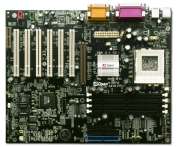Overclocking
 At
first I had some trouble enabling FSB speeds higher than 124 MHz. I actually
had to go through the manual a second time to find that there is a jumper
on the motherboard that enables the higher FSB speeds. By higher I mean 133
MHz to 150 MHz. If you happen to get an insanely fast Pentium III for your
setup you can push it till it melts, or almost at any rate. Once I set the
jumper all the higher FSB speeds were available in the BIOS setup area. For
those of you who are worried, this board does feature voltage adjustments.
At
first I had some trouble enabling FSB speeds higher than 124 MHz. I actually
had to go through the manual a second time to find that there is a jumper
on the motherboard that enables the higher FSB speeds. By higher I mean 133
MHz to 150 MHz. If you happen to get an insanely fast Pentium III for your
setup you can push it till it melts, or almost at any rate. Once I set the
jumper all the higher FSB speeds were available in the BIOS setup area. For
those of you who are worried, this board does feature voltage adjustments.
One thing
that I'd like to point out with the FSB settings is that they go from 133
to 140 to 150. It would have made life a lot easier to see either a 135 or
138 MHz setting and possibly a couple between 140 and 150. I know for a fact
that this Pentium III can run without a hitch at 138 MHz.
Conclusions
Not too long ago I had seen enough
Apollo Pro boards to make me never consider looking at another one again.
You can't imagine how happy I am I decided to take a look at the AX34 Pro
II. This is the best Apollo Pro board I've come across - and by that I mean
it is leaps ahead of the other boards I've tried. The
combination of six PCI slots, four USB ports, and benchmarking results that
make it very comparable to the latest Duron systems on the market make it
a great candidate to build a new system with. Some people will miss the ISA
slot, but for myself I haven't purchased an ISA component in 18 months and
have no plans to ever buy another one again. With all those PCI slots and
USB ports just about anyone should be able to pack their system full of peripherals.
Also of special note are the four memory slots. When exactly did three memory
slots become the industry standard? More importantly - why?
 On
top of being made on that really cool black PCB is the fact that the AX34
Pro II can be customized. Optional are Dr. LED and Dr. Voice. Dr. LED is a
set of LED lights that plug into the board and will tell you with a color
combination what has gone wrong with your install or why your board suddenly
isn't working. On the same train of thought is Dr. Voice. Let your board tell
you in English, German, Chinese, or Japanese what is wrong. I can think of
all sorts of fun by running Dr. Voice in a language I don't speak. Now not
only is there a challenge of figuring out what is wrong with the configuration
but there is also someone talking in a language I can't understand a word
of. I wonder if it is programmed to call someone an idiot? OK, feel free to
use it in your native tongue for the purpose it was designed.
On
top of being made on that really cool black PCB is the fact that the AX34
Pro II can be customized. Optional are Dr. LED and Dr. Voice. Dr. LED is a
set of LED lights that plug into the board and will tell you with a color
combination what has gone wrong with your install or why your board suddenly
isn't working. On the same train of thought is Dr. Voice. Let your board tell
you in English, German, Chinese, or Japanese what is wrong. I can think of
all sorts of fun by running Dr. Voice in a language I don't speak. Now not
only is there a challenge of figuring out what is wrong with the configuration
but there is also someone talking in a language I can't understand a word
of. I wonder if it is programmed to call someone an idiot? OK, feel free to
use it in your native tongue for the purpose it was designed.
I'm hoping
for a BIOS update that offers a few more speeds between 133 MHz and 150 MHz.
A BIOS update that allows the memory modes of "faster" and "fastest"
that I used on the AK33 board would also be much appreciated.
Victor
Oshiro December 11, 2000
